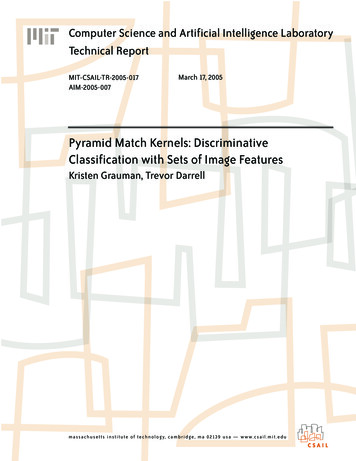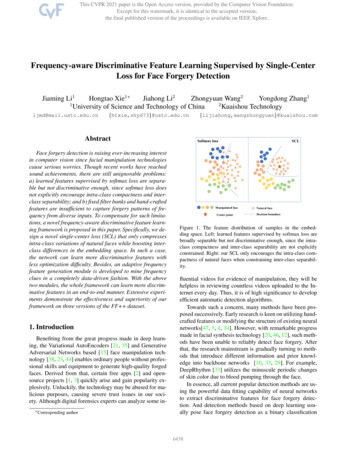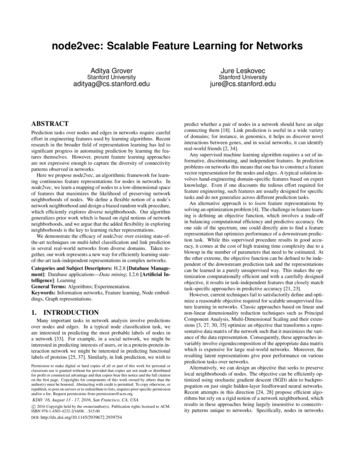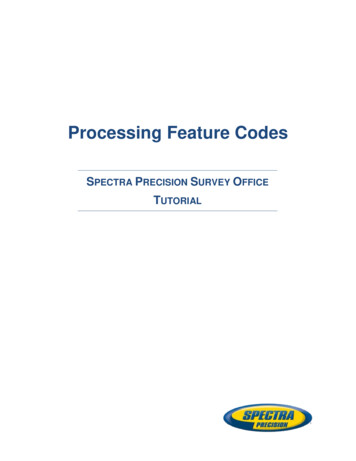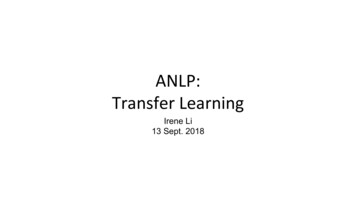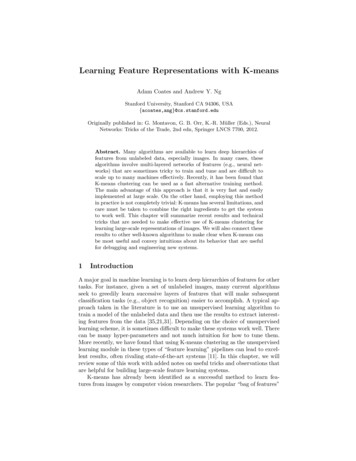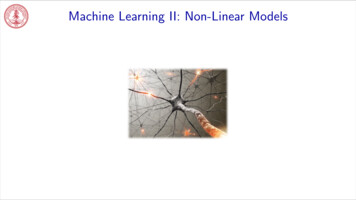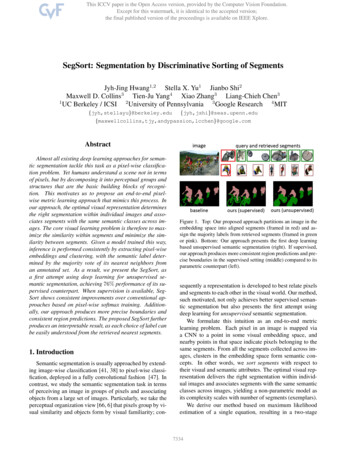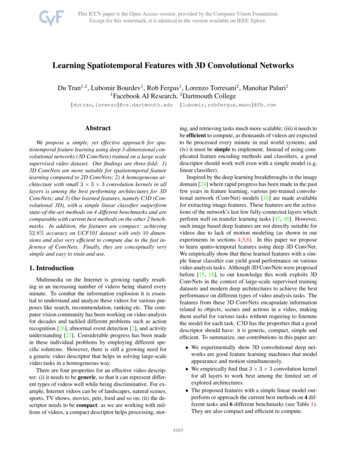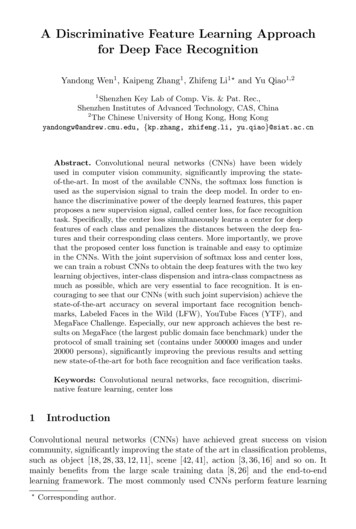
Transcription
A Discriminative Feature Learning Approachfor Deep Face RecognitionYandong Wen1 , Kaipeng Zhang1 , Zhifeng Li1? and Yu Qiao1,21Shenzhen Key Lab of Comp. Vis. & Pat. Rec.,Shenzhen Institutes of Advanced Technology, CAS, China2The Chinese University of Hong Kong, Hong Kongyandongw@andrew.cmu.edu, {kp.zhang, zhifeng.li, yu.qiao}@siat.ac.cnAbstract. Convolutional neural networks (CNNs) have been widelyused in computer vision community, significantly improving the stateof-the-art. In most of the available CNNs, the softmax loss function isused as the supervision signal to train the deep model. In order to enhance the discriminative power of the deeply learned features, this paperproposes a new supervision signal, called center loss, for face recognitiontask. Specifically, the center loss simultaneously learns a center for deepfeatures of each class and penalizes the distances between the deep features and their corresponding class centers. More importantly, we provethat the proposed center loss function is trainable and easy to optimizein the CNNs. With the joint supervision of softmax loss and center loss,we can train a robust CNNs to obtain the deep features with the two keylearning objectives, inter-class dispension and intra-class compactness asmuch as possible, which are very essential to face recognition. It is encouraging to see that our CNNs (with such joint supervision) achieve thestate-of-the-art accuracy on several important face recognition benchmarks, Labeled Faces in the Wild (LFW), YouTube Faces (YTF), andMegaFace Challenge. Especially, our new approach achieves the best results on MegaFace (the largest public domain face benchmark) under theprotocol of small training set (contains under 500000 images and under20000 persons), significantly improving the previous results and settingnew state-of-the-art for both face recognition and face verification tasks.Keywords: Convolutional neural networks, face recognition, discriminative feature learning, center loss1IntroductionConvolutional neural networks (CNNs) have achieved great success on visioncommunity, significantly improving the state of the art in classification problems,such as object [18, 28, 33, 12, 11], scene [42, 41], action [3, 36, 16] and so on. Itmainly benefits from the large scale training data [8, 26] and the end-to-endlearning framework. The most commonly used CNNs perform feature learning?Corresponding author.
2Yandong Wen, Kaipeng Zhang, Zhifeng Li and Yu QiaoInputConvolutionalFeature LearningDeeply unctionClassifyFace cted LabelsFig. 1. The typical framework of convolutional neural networks.and label prediction, mapping the input data to deep features (the output of thelast hidden layer), then to the predicted labels, as shown in Figure 1.In generic object, scene or action recognition, the classes of the possibletesting samples are within the training set, which is also referred to close-setidentification. Therefore, the predicted labels dominate the performance andsoftmax loss is able to directly address the classification problems. In this way,the label prediction (the last fully connected layer) acts like a linear classifierand the deeply learned features are prone to be separable.For face recognition task, the deeply learned features need to be not onlyseparable but also discriminative. Since it is impractical to pre-collect all thepossible testing identities for training, the label prediction in CNNs is not always applicable. The deeply learned features are required to be discriminativeand generalized enough for identifying new unseen classes without label prediction. Discriminative power characterizes features in both the compact intra-classvariations and separable inter-class differences, as shown in Figure 1. Discriminative features can be well-classified by nearest neighbor (NN) [7] or k-nearestneighbor (k-NN) [9] algorithms, which do not necessarily depend on the labelprediction. However, the softmax loss only encourage the separability of features.The resulting features are not sufficiently effective for face recognition.Constructing highly efficient loss function for discriminative feature learning in CNNs is non-trivial. Because the stochastic gradient descent (SGD) [19]optimizes the CNNs based on mini-batch, which can not reflect the global distribution of deep features very well. Due to the huge scale of training set, it isimpractical to input all the training samples in every iteration. As alternativeapproaches, contrastive loss [10, 29] and triplet loss [27] respectively constructloss functions for image pairs and triplet. However, compared to the image samples, the number of training pairs or triplets dramatically grows. It inevitablyresults in slow convergence and instability. By carefully selecting the image pairsor triplets, the problem may be partially alleviated. But it significantly increasesthe computational complexity and the training procedure becomes inconvenient.In this paper, we propose a new loss function, namely center loss, to efficiently enhance the discriminative power of the deeply learned features in neural
A Discriminative Feature Learning Approach for Deep Face Recognition3networks. Specifically, we learn a center (a vector with the same dimension as afeature) for deep features of each class. In the course of training, we simultaneously update the center and minimize the distances between the deep featuresand their corresponding class centers. The CNNs are trained under the joint supervision of the softmax loss and center loss, with a hyper parameter to balancethe two supervision signals. Intuitively, the softmax loss forces the deep featuresof different classes staying apart. The center loss efficiently pulls the deep features of the same class to their centers. With the joint supervision, not only theinter-class features differences are enlarged, but also the intra-class features variations are reduced. Hence the discriminative power of the deeply learned featurescan be highly enhanced. Our main contributions are summarized as follows.– We propose a new loss function (called center loss) to minimize the intraclass distances of the deep features. To be best of our knowledge, this isthe first attempt to use such a loss function to help supervise the learning ofCNNs. With the joint supervision of the center loss and the softmax loss, thehighly discriminative features can be obtained for robust face recognition,as supported by our experimental results.– We show that the proposed loss function is very easy to implement in theCNNs. Our CNN models are trainable and can be directly optimized by thestandard SGD.– We present extensive experiments on the datasets of MegaFace Challenge [23](the largest public domain face database with 1 million faces for recognition)and set new state-of-the-art under the evaluation protocol of small trainingset. We also verify the excellent performance of our new approach on LabeledFaces in the Wild (LFW) [15] and YouTube Faces (YTF) datasets [38].2Related workFace recognition via deep learning has achieved a series of breakthrough in theseyears [30, 34, 29, 27, 25, 37]. The idea of mapping a pair of face images to a distance starts from [6]. They train siamese networks for driving the similaritymetric to be small for positive pairs, and large for the negative pairs. Hu et al.[13] learn a nonlinear transformations and yield discriminative deep metric witha margin between positive and negative face image pairs. There approaches arerequired image pairs as input.Very recently, [34, 31] supervise the learning process in CNNs by challengingidentification signal (softmax loss function), which brings richer identity-relatedinformation to deeply learned features. After that, joint identification-verificationsupervision signal is adopted in [29, 37], leading to more discriminative features.[32] enhances the supervision by adding a fully connected layer and loss functionsto each convolutional layer. The effectiveness of triplet loss has been demonstrated in [27, 25, 21]. With the deep embedding, the distance between an anchor and apositive are minimized, while the distance between an anchor and a negative aremaximized until the margin is met. They achieve state-of-the-art performancein LFW and YTF datasets.
4Yandong Wen, Kaipeng Zhang, Zhifeng Li and Yu Qiao3The Proposed ApproachIn this Section, we elaborate our approach. We first use a toy example to intuitively show the distributions of the deeply learned features. Inspired by thedistribution, we propose the center loss to improve the discriminative power ofthe deeply learned features, followed by some discussions.Table 1. The CNNs architecture we use in toy example, called LeNets . Some ofthe convolution layers are followed by max pooling. (5, 32)/1,2 2 denotes 2 cascadedconvolution layers with 32 filters of size 5 5, where the stride and padding are 1 and2 respectively. 2/2,0 denotes the max-pooling layers with grid of 2 2, where the strideand padding are 2 and 0 respectively. In LeNets , we use the Parametric RectifiedLinear Unit (PReLU) [12] as the nonlinear unit.stage 1stage 2stage 3stage 4Layerconvpoolconvpoolconvpool FCLeNets(5, 20)/1,0 2/2,0 (5, 50)/1,0 2/2,0500LeNets (5, 32)/1,2 2 2/2,0 (5, 64)/1,2 2 2/2,0 (5, 128)/1,2 2 2/2,023.1A toy exampleIn this section, a toy example on MNIST [20] dataset is presented. We modifythe LeNets [19] to a deeper and wider network, but reduce the output number ofthe last hidden layer to 2 (It means that the dimension of the deep features is 2).So we can directly plot the features on 2-D surface for visualization. More detailsof the network architecture are given in Table 1. The softmax loss function ispresented as follows.LS mXi 1WyT xi byielog Pnj 1iT x bijeWj(1)In Equation 1, xi Rd denotes the ith deep feature, belonging to the yi thclass. d is the feature dimension. Wj Rd denotes the jth column of the weightsW Rd n in the last fully connected layer and b Rn is the bias term. Thesize of mini-batch and the number of class is m and n, respectively. We omitthe biases for simplifying analysis. (In fact, the performance is nearly of nodifference).The resulting 2-D deep features are plotted in Figure 2 to illustrate thedistribution. Since the last fully connected layer acts like a linear classifier, thedeep features of different classes are distinguished by decision boundaries. FromFigure 2 we can observe that: i) under the supervision of softmax loss, the deeplylearned features are separable, and ii) the deep features are not discriminativeenough, since they still show significant intra-class variations. Consequently, itis not suitable to directly use these features for recognition.
A Discriminative Feature Learning Approach for Deep Face Recognition50123456789(a)(b)Fig. 2. The distribution of deeply learned features in (a) training set (b) testing set,both under the supervision of softmax loss, where we use 50K/10K train/test splits.The points with different colors denote features from different classes. Best viewedin color.3.2The center lossSo, how to develop an effective loss function to improve the discriminative powerof the deeply learned features? Intuitively, minimizing the intra-class variationswhile keeping the features of different classes separable is the key. To this end,we propose the center loss function, as formulated in Equation 2.LC m1Xkxi cyi k222 i 1(2)The cyi Rd denotes the yi th class center of deep features. The formulationeffectively characterizes the intra-class variations. Ideally, the cyi should be updated as the deep features changed. In other words, we need to take the entiretraining set into account and average the features of every class in each iteration,which is inefficient even impractical. Therefore, the center loss can not be useddirectly. This is possibly the reason that such a center loss has never been usedin CNNs until now.To address this problem, we make two necessary modifications. First, insteadof updating the centers with respect to the entire training set, we perform theupdate based on mini-batch. In each iteration, the centers are computed byaveraging the features of the corresponding classes (In this case, some of thecenters may not update). Second, to avoid large perturbations caused by fewmislabelled samples, we use a scalar α to control the learning rate of the centers.The gradients of LC with respect to xi and update equation of cyi are computedas: LC xi cyi xPm ii j) · (cj xi )i 1 δ(yP cj 1 mi 1 δ(yi j)(3)(4)
6Yandong Wen, Kaipeng Zhang, Zhifeng Li and Yu Qiaowhere δ(condition) 1 if the condition is satisfied, and δ(condition) 0 ifnot. α is restricted in [0, 1]. We adopt the joint supervision of softmax loss andcenter loss to train the CNNs for discriminative feature learning. The formulationis given in Equation 5.L LS λLC mXi 1WyT xi byielog Pnj 1iWjT xi bje mλXkxi cyi k222 i 1(5)Clearly, the CNNs supervised by center loss are trainable and can be optimized by standard SGD. A scalar λ is used for balancing the two loss functions.The conventional softmax loss can be considered as a special case of this jointsupervision, if λ is set to 0. In Algorithm 1, we summarize the learning detailsin the CNNs with joint supervision.Algorithm 1 The discriminative feature learning algorithmInput: Training data {xi }. Initialized parameters θC in convolution layers. Parameters W and {cj j 1, 2, ., n} in loss layers, respectively. Hyperparameter λ, αand learning rate µt . The number of iteration t 0.Output: The parameters θC .1: while not converge do2:t t 1.3:Compute the joint loss by Lt LtS LtC .tt Lt Lt4:Compute the backpropagation error Lfor each i by L xSt λ · xCt . xt xtiititt LUpdate the parameters W by W t 1 W t µt · Wt W µ ·t 1ttUpdate the parameters cj for each j by cj cj α · cj .P Lt xtit 1t7:Update the parameters θC by θC θC µt mi xt · θ t .iC8: end while5:6: LtS. W tiWe also conduct experiments to illustrate how the λ influences the distribution. Figure 3 shows that different λ lead to different deep feature distributions.With proper λ, the discriminative power of deep features can be significantly enhanced. Moreover, features are discriminative within a wide range of λ. Therefore, the joint supervision benefits the discriminative power of deeply learnedfeatures, which is crucial for face recognition.3.3Discussion– The necessity of joint supervision. If we only use the softmax loss assupervision signal, the resulting deeply learned features would contain largeintra-class variations. On the other hand, if we only supervise CNNs by thecenter loss, the deeply learned features and centers will degraded to zeros (Atthis point, the center loss is very small). Simply using either of them could
A Discriminative Feature Learning Approach for Deep Face Recognition70123456789(a)(b)0123456789(c)(d)Fig. 3. The distribution of deeply learned features under the joint supervision of softmax loss and center loss. The points with different colors denote features from differentclasses. Different λ lead to different deep feature distributions (α 0.5). The whitedots (c0 , c1 ,.,c9 ) denote 10 class centers of deep features. Best viewed in color.not achieve discriminative feature learning. So it is necessary to combinethem to jointly supervise the CNNs, as confirmed by our experiments.– Compared to contrastive loss and triplet loss. Recently, contrastiveloss [29, 37] and triplet loss [27] are also proposed to enhance the discriminative power of the deeply learned face features. However, both contrastiveloss and triplet loss suffer from dramatic data expansion when constitutingthe sample pairs or sample triplets from the training set. Our center lossenjoys the same requirement as the softmax loss and needs no complex recombination of the training samples. Consequently, the supervised learningof our CNNs is more efficient and easy-to-implement. Moreover, our lossfunction targets more directly on the learning objective of the intra-classcompactness, which is very beneficial to the discriminative feature learning.4ExperimentsThe necessary implementation details are given in Section 4.1. Then we investigate the sensitiveness of the parameter λ and α in Section 4.2. In Section 4.3 and4.4, extensive experiments are conducted on several public domain face datasets(LFW [15], YTF [38] and MegaFace Challenge [23]) to verify the effectivenessof the proposed approach.
8Yandong Wen, Kaipeng Zhang, Zhifeng Li and Yu QiaoC: The convolution layerP: The max-pooling layerLC: The local convolution layerFC: The fully connected layerSoftmaxLossInputCCPCPLCPLCPLCFCCenterLossFig. 4. The CNN architecture using for face recognition experiments. Joint supervisionis adopted. The filter sizes in both convolution and local convolution layers are 3 3 withstride 1, followed by PReLU [12] nonlinear units. Weights in three local convolutionlayers are locally shared in the regions of 4 4, 2 2 and 1 1 respectively. Thenumber of the feature maps are 128 for the convolution layers and 256 for the localconvolution layers. The max-pooling grid is 2 2 and the stride is 2. The output of the4th pooling layer and the 3th local convolution layer are concatenated as the input ofthe 1st fully connected layer. The output dimension of the fully connected layer is 512.Best viewed in color.4.1Implementation DetailsPreprocessing. All the faces in images and their landmarks are detected bythe recently proposed algorithms [40]. We use 5 landmarks (two eyes, nose andmouth corners) for similarity transformation. When the detection fails, we simplydiscard the image if it is in training set, but use the provided landmarks if itis a testing image. The faces are cropped to 112 96 RGB images. Followinga previous convention, each pixel (in [0, 255]) in RGB images is normalized bysubtracting 127.5 then dividing by 128.Training data. We use the web-collected training data, including CASIAWebFace [39], CACD2000 [4], Celebrity [22]. After removing the images withidentities appearing in testing datasets, it roughly goes to 0.7M images of 17,189unique persons. In Section 4.4, we only use 0.49M training data, following theprotocol of small training set. The images are horizontally flipped for data augmentation. Compared to [27] (200M), [34] (4M) and [25] (2M), it is a small scaletraining set.Detailed settings in CNNs. We implement the CNN model using the Caffe[17] library with our modifications. All the CNN models in this Section are thesame architecture and the details are given in Figure 4. For fair comparison,we respectively train three kind of models under the supervision of softmax loss(model A), softmax loss and contrastive loss (model B), softmax loss andcenter loss (model C). These models are trained with batch size of 256 on twoGPUs (TitanX). For model A and model C, the learning rate is started from 0.1,
A Discriminative Feature Learning Approach for Deep Face Recognition9and divided by 10 at the 16K, 24K iterations. A complete training is finished at28K iterations and roughly costs 14 hours. For model B, we find that it convergesslower. As a result, we initialize the learning rate to 0.1 and switch it at the 24K,36K iterations. Total iteration is 42K and costs 22 hours.Detailed settings in testing. The deep features are taken from the outputof the first FC layer. We extract the features for each image and its horizontallyflipped one, and concatenate them as the representation. The score is computedby the Cosine Distance of two features after PCA. Nearest neighbor [7] andthreshold comparison are used for both identification and verification tasks. Notethat, we only use single model for all the testing.4.2Experiments on the parameter λ and αThe hyper parameter λ dominates the intra-class variations and α controls thelearning rate of center c in model C. Both of them are essential to our model. So we conduct two experiments to investigate the sensitiveness of the twoparameters.99.5V e rifica tion Acc urac y( % )Verification Accuracy(%)99.59998.59897.59796.5-40 1 105 10-4-33 101 10/ (at log scale)(a)-25 10-21 10-19998.59897.59796.50.01 0.050.20.40.60.81(b)Fig. 5. Face verification accuracies on LFW dataset, respectively achieve by (a) modelswith different λ and fixed α 0.5. (b) models with different α and fixed λ 0.003.In the first experiment, we fix α to 0.5 and vary λ from 0 to 0.1 to learndifferent models. The verification accuracies of these models on LFW dataset areshown in Figure 5. It is very clear that simply using the softmax loss (in this caseλ is 0) is not a good choice, leading to poor verification performance. Properlychoosing the value of λ can improve the verification accuracy of the deeplylearned features. We also observe that the verification performance of our modelremains largely stable across a wide range of λ. In the second experiment, we fixλ 0.003 and vary α from 0.01 to 1 to learn different models. The verificationaccuracies of these models on LFW are illustrated in Figure 5. Likewise, theverification performance of our model remains largely stable across a wide rangeof α.
10Yandong Wen, Kaipeng Zhang, Zhifeng Li and Yu Qiao(a) Face images in LFW(b) Face videos in YTFFig. 6. Some face images and videos in LFW and YTF datasets. The face image pairsin green frames are the positive pairs (the same person), while the ones in red framesare negative pairs. The white bounding box in each image indicates the face for testing.4.3Experiments on the LFW and YTF datasetsIn this part, we evaluate our single model on two famous face recognition benchmarks in unconstrained environments, LFW and YTF datasets. They are excellent benchmarks for face recognition in image and video. Some examples ofthem are illustrated in Figure 6. Our model is trained on the 0.7M outside data,with no people overlapping with LFW and YTF. In this section, we fix the λ to0.003 and the α is 0.5 for model C.LFW dataset contains 13,233 web-collected images from 5749 different identities, with large variations in pose, expression and illuminations. Followingthe standard protocol of unrestricted with labeled outside data [14]. We test on6,000 face pairs and report the experiment results in Table 2.YTF dataset consists of 3,425 videos of 1,595 different people, with anaverage of 2.15 videos per person. The clip durations vary from 48 frames to 6,070frames, with an average length of 181.3 frames. Again, we follow the unrestrictedwith labeled outside data protocol and report the results on 5,000 video pairs inTable 2.From the results in Table 2, we have the following observations. First, modelC (jointly supervised by the softmax loss and the center loss) beats the baselineone (model A, supervised by the softmax loss only) by a significant margin, improving the performance from (97.37% on LFW and 91.1% on YTF) to (99.28%on LFW and 94.9% on YTF). This shows that the joint supervision can notablyenhance the discriminative power of deeply learned features, demonstrating theeffectiveness of the center loss. Second, compared to model B (supervised bythe combination of the softmax loss and the contrastive loss), model C achievesbetter performance (99.10% v.s. 99.28% and 93.8% v.s. 94.9%). This shows the
A Discriminative Feature Learning Approach for Deep Face Recognition11Table 2. Verification performance of different methods on LFW and YTF datasetsMethodDeepFace [34]DeepID-2 [32]DeepID-2 [32]FaceNet [27]Deep FR [25]Baidu [21]model Amodel Bmodel C (Proposed)Images Networks Acc. on LFW Acc. on 199.10%93.8%0.7M199.28%94.9%advantage of the center loss over the contrastive loss in the designed CNNs.Last, compared to the state-of-the-art results on the two databases, the resultsof the proposed model C (much less training data and simpler network architecture) are consistently among the top-ranked sets of approaches based on the twodatabases, outperforming most of the existing results in Table 2. This shows theadvantage of the proposed CNNs.4.4Experiments on the dataset of MegaFace ChallengeMegaFace datasets are recently released as a testing benchmark. It is a verychallenging dataset and aims to evaluate the performance of face recognitionalgorithms at the million scale of distractors (people who are not in thetesting set). MegaFace datasets include gallery set and probe set. The galleryset consists of more than 1 million images from 690K different individuals, as asubset of Flickr photos [35] from Yahoo. The probe set using in this challengeare two existing databases: Facescrub [24] and FGNet [1]. Facescrub datasetis publicly available dataset, containing 100K photos of 530 unique individuals(55,742 images of males and 52,076 images of females). The possible bias canbe reduced by sufficient samples in each identity. FGNet dataset is a face agingdataset, with 1002 images from 82 identities. Each identity has multiple faceimages at different ages (ranging from 0 to 69).There are several testing scenarios (identification, verification and pose invariance) under two protocols (large or small training set). The training set isdefined as small if it contains less than 0.5M images and 20K subjects. Followingthe protocol of small training set, we reduce the size of training images to 0.49Mbut maintaining the number of identities unchanged (i.e. 17,189 subjects). Theimages overlapping with Facescrub dataset are discarded. For fair comparison,we also train three kinds of CNN models on small training set under differentsupervision signals. The resulting models are called model A-, model B- andmodel C-, respectively. Following the same settings in Section 4.3, the λ is 0.003and the α is 0.5 in model C-. We conduct the experiments with the providedcode [23], which only tests our algorithm on one of the three gallery (Set 1).
12Yandong Wen, Kaipeng Zhang, Zhifeng Li and Yu QiaoProbe SetGallery (at million scale)Fig. 7. Some example face images in MegaFace dataset, including probe set and gallery.The gallery consists of at least one correct image and millions of distractors. Because ofthe great intra-variations in each subject and varieties of distractors, the identificationand verification task become very challenging.Face Identification. Face identification aims to match a given probe imageto the ones with the same person in gallery. In this task, we need to compute thesimilarity between each given probe face image and the gallery, which includesat least one image with the same identity as the probe one. Besides, the gallerycontains different scale of distractors, from 10 to 1 million, leading to increasingchallenge in testing. More details can be found in [23]. In face identificationexperiments, we present the results by Cumulative Match Characteristics (CMC)curves. It reveals the probability that a correct gallery image is ranked on top-K.The results are shown in Figure 8.Face Verification. For face verification, the algorithm should decide a givenpair of images is the same person or not. 4 billion negative pairs between theprobe and gallery datasets are produced. We compute the True Accept Rate(TAR) and False Accept Rate (FAR) and plot the Receiver Operating Characteristic (ROC) curves of different methods in Figure 9.We compare our method against many existing ones, including i) LBP [2]and JointBayes [5], ii) our baseline deep models (model A- and model B-), andiii) deep models submitted by other groups. As can be seen from Figure 8 andFigure 9, the hand-craft features and shallow model perform poorly. Their accuracies drop sharply with the increasing number of distractors. In addition,the methods based on deep learning perform better than the traditional ones.However, there is still much room for performance improvement. Finally, withthe joint supervision of softmax loss and center loss, model C- achieves the bestresults, not only surpassing the model A- and model B- by a clear margin butalso significantly outperforming the other published methods.To meet the practical demand, face recognition models should achieve highperformance against millions of distractors. In this case, only Rank-1 identifica-
1001008080Identification Rate(%)Identification Rate(%)A Discriminative Feature Learning Approach for Deep Face Recognition6040200 01010 110 210 310 410 5# distractors / (at log scale)model C- (Proposed)model BNTechLAB smallBarebones FRmodel A3DiVi-tdvm6JointBayesLBPRandom6040200 01010 61310 110 210 3# distractors / (at log scale)10 4110.80.8True Positive RateTrue Positive RateFig. 8. CMC curves of different methods (under the protocol of small training set) with(a) 1M and (b) 10K distractors on Set 1. The results of other methods are providedby MegaFace team.0.60.40.60.40.20.20 -610model C- (Proposed)model BNTechLAB smallBarebones FRmodel se Positive Rate10-10 -61010-510-410-310-2False Positive Rate10-1Fig. 9. ROC curves of different methods (under the protocol of small training set) with(a) 1M and (b) 10K distractors on Set 1. The results of other methods are providedby MegaFace team.tion rate with at least 1M distractors and verification rate at low false acceptrate (e.g., 10 6 ) are very meaningful [23]. We report the experimental results ofdifferent methods in Table 3 and 4.From these results we have the following observations. First, not surprisingly,model C- consistently outperforms model A- and model B- by a significant margin in both face identification and verification tasks, confirming the advantageof the designed loss function. Second, under the evaluation protocol of smalltraining set, the proposed model C- achieves the best results in both face
Face recognition via deep learning has achieved a series of breakthrough in these years [30,34,29,27,25,37]. The idea of mapping a pair of face images to a dis-tance starts from [6]. They train siamese networks for driving the similarity metric to be small for positive pairs, and large for the negative pairs. Hu et al.
